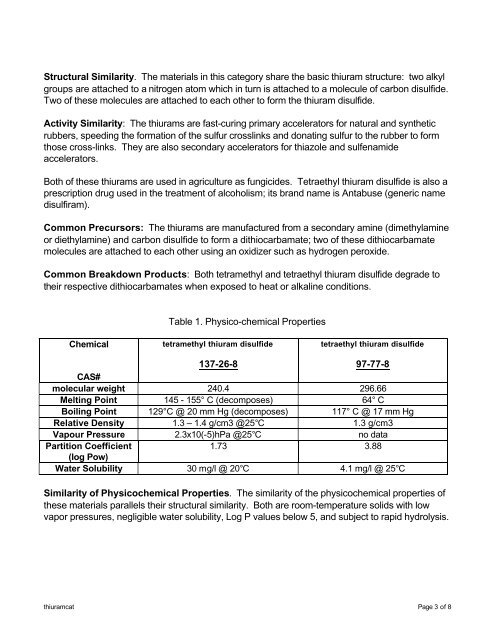American Chemistry Council/Thiuram Test Plan & Robust Summary
American Chemistry Council/Thiuram Test Plan & Robust Summary
American Chemistry Council/Thiuram Test Plan & Robust Summary
You also want an ePaper? Increase the reach of your titles
YUMPU automatically turns print PDFs into web optimized ePapers that Google loves.
Structural Similarity. The materials in this category share the basic thiuram structure: two alkyl<br />
groups are attached to a nitrogen atom which in turn is attached to a molecule of carbon disulfide.<br />
Two of these molecules are attached to each other to form the thiuram disulfide.<br />
Activity Similarity: The thiurams are fast-curing primary accelerators for natural and synthetic<br />
rubbers, speeding the formation of the sulfur crosslinks and donating sulfur to the rubber to form<br />
those cross-links. They are also secondary accelerators for thiazole and sulfenamide<br />
accelerators.<br />
Both of these thiurams are used in agriculture as fungicides. Tetraethyl thiuram disulfide is also a<br />
prescription drug used in the treatment of alcoholism; its brand name is Antabuse (generic name<br />
disulfiram).<br />
Common Precursors: The thiurams are manufactured from a secondary amine (dimethylamine<br />
or diethylamine) and carbon disulfide to form a dithiocarbamate; two of these dithiocarbamate<br />
molecules are attached to each other using an oxidizer such as hydrogen peroxide.<br />
Common Breakdown Products: Both tetramethyl and tetraethyl thiuram disulfide degrade to<br />
their respective dithiocarbamates when exposed to heat or alkaline conditions.<br />
Chemical<br />
Table 1. Physico-chemical Properties<br />
tetramethyl thiuram disulfide<br />
tetraethyl thiuram disulfide<br />
137-26-8<br />
97-77-8<br />
CAS#<br />
molecular weight 240.4 296.66<br />
Melting Point 145 - 155° C (decomposes) 64° C<br />
Boiling Point 129°C @ 20 mm Hg (decomposes) 117° C @ 17 mm Hg<br />
Relative Density 1.3 – 1.4 g/cm3 @25°C 1.3 g/cm3<br />
Vapour Pressure 2.3x10(-5)hPa @25°C no data<br />
Partition Coefficient<br />
(log Pow)<br />
1.73 3.88<br />
Water Solubility 30 mg/l @ 20°C 4.1 mg/l @ 25°C<br />
Similarity of Physicochemical Properties. The similarity of the physicochemical properties of<br />
these materials parallels their structural similarity. Both are room-temperature solids with low<br />
vapor pressures, negligible water solubility, Log P values below 5, and subject to rapid hydrolysis.<br />
thiuramcat Page 3 of 8

















